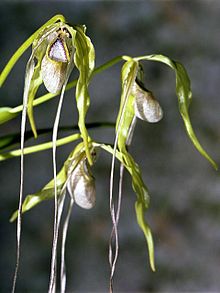Phragmipedium
| Phragmipedium | |
|---|---|
 |
|
| Phragmipedium warscewiczianum | |
| Scientific classification | |
| Kingdom: | Plantae |
| (unranked): | Angiosperms |
| (unranked): | Monocots |
| Order: | Asparagales |
| Family: | Orchidaceae |
| Subfamily: | Cypripedioideae |
| Tribe: | Phragmipedieae |
| Subtribe: | Phragmipediinae |
| Genus: |
Phragmipedium Rolfe, 1896 |
| Synonyms | |
|
|
Phragmipedium is a genus of the Orchid family (Orchidaceae) (Subfamily Cypripedioideae) and the only genus comprised in the tribe Phragmipedieae and subtribe Phragmipediinae. The name of the genus is derived from the Greek phragma, which means "division", and pedium, which means "slipper" (referring to the pouch). It is abbreviated 'Phrag' in trade journals.
About 20 species of these lady's slipper orchids are known from SW Mexico, Central and tropical South America.
All members of the genus Phragmipedium are listed in Appendix I of the Convention on International Trade in Endangered Species (CITES).
The genus Phragmipedium is divided into several sections :
The exact number of species is still being discussed among specialists : O. Gruss recognizes 20 species, compared to the 15 species accepted by Lucile M. McCook (see References).
Most Phragmipedium species are either terrestrial, epiphytic or lithophytic in habit. They show a unique shieldlike staminode, long, moustache-like petals and a 3-locular ovary. The large pouchlike lip is curved inwards at the margins. The acute leaves attain a length of about 80 cm. The stem lacks pseudobulbs and grows about 80 cm high, showing 2 to 3 flowers.
Phragmipedium besseae was first found in Peru by Elizabeth Locke Besse in 1981. Soon afterwards, the site was plundered and destroyed by orchid hunters. Luckily enough seed was preserved, to avert extinction. This orchid is unusual, because its flowers have a bright orange-red to almost strong salmon-red color (there is also a yellow variety), unseen in any lady's slipper orchid. The oval-shaped petals are wide. The narrow leaves are elliptic in shape. It has since been used extensively in hybridization.
...
Wikipedia
